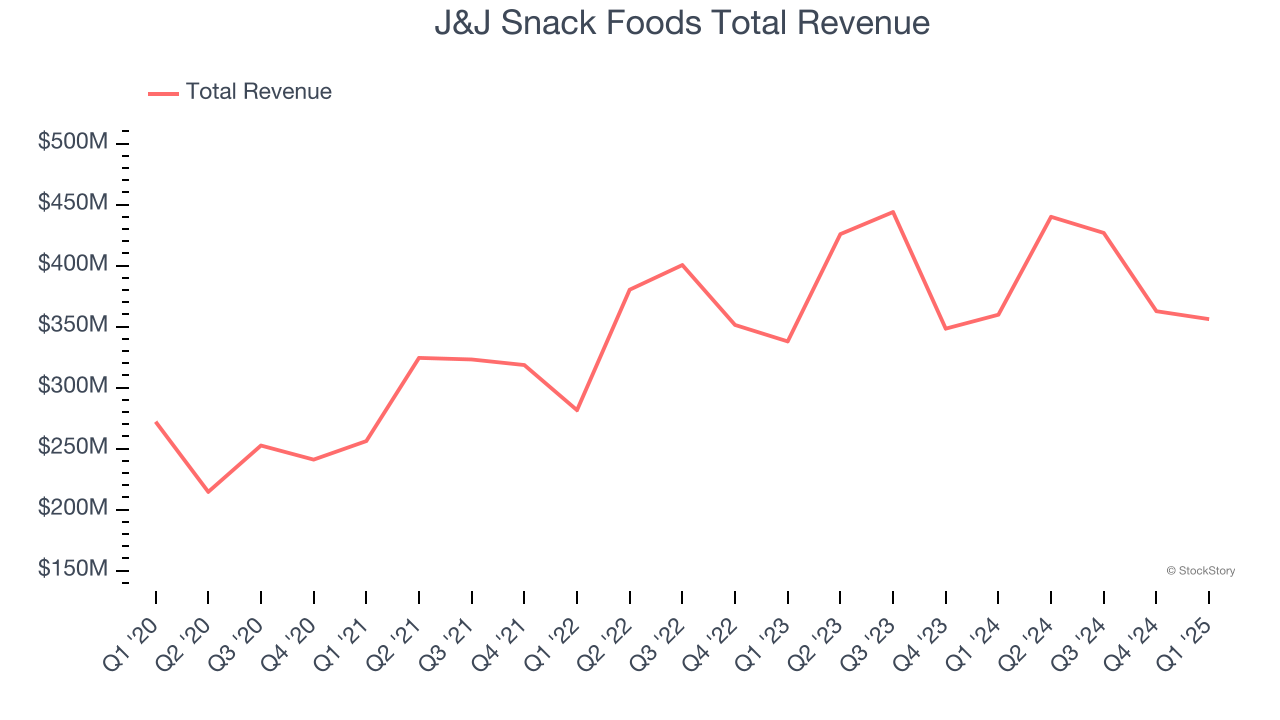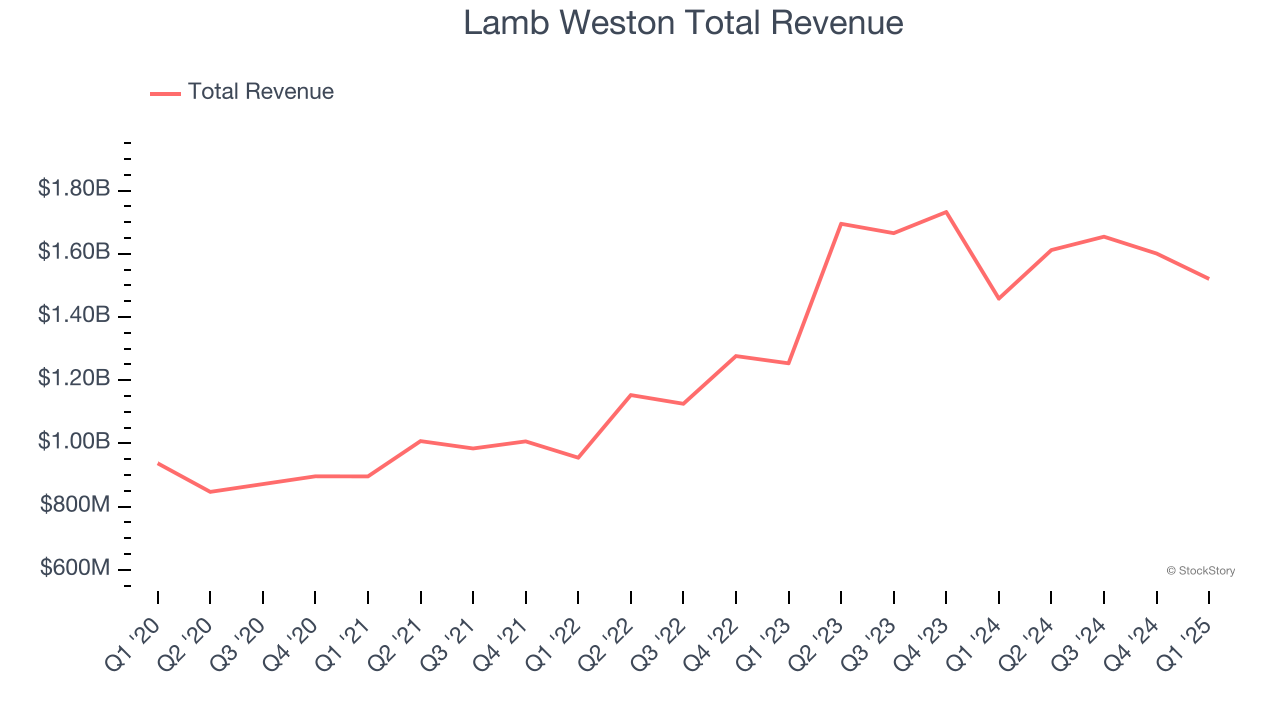
Looking back on shelf-stable food stocks’ Q1 earnings, we examine this quarter’s best and worst performers, including J&J Snack Foods (NASDAQ: JJSF) and its peers.
As America industrialized and moved away from an agricultural economy, people faced more demands on their time. Packaged foods emerged as a solution offering convenience to the evolving American family, whether it be canned goods or snacks. Today, Americans seek brands that are high in quality, reliable, and reasonably priced. Furthermore, there's a growing emphasis on health-conscious and sustainable food options. Packaged food stocks are considered resilient investments. People always need to eat, so these companies can enjoy consistent demand as long as they stay on top of changing consumer preferences. The industry spans from multinational corporations to smaller specialized firms and is subject to food safety and labeling regulations.
The 18 shelf-stable food stocks we track reported a slower Q1. As a group, revenues missed analysts’ consensus estimates by 1% while next quarter’s revenue guidance was 0.5% above.
Amidst this news, share prices of the companies have had a rough stretch. On average, they are down 6% since the latest earnings results.
J&J Snack Foods (NASDAQ: JJSF)
Best known for its SuperPretzel soft pretzels and ICEE frozen drinks, J&J Snack Foods (NASDAQ: JJSF) produces a range of snacks and beverages and distributes them primarily to supermarket and food service customers.
J&J Snack Foods reported revenues of $356.1 million, down 1% year on year. This print fell short of analysts’ expectations by 3.2%. Overall, it was a disappointing quarter for the company with a significant miss of analysts’ adjusted operating income estimates.
Dan Fachner, J&J Snack Foods Chairman, President, and CEO stated, “J & J Snack Foods total net sales for our fiscal second quarter declined 1.0% to $356.1 million as compared to the prior year quarter, which primarily was driven by lower sales in our Frozen Beverage and Food Service segments, partly offset by growth in our Retail business.

Unsurprisingly, the stock is down 12.1% since reporting and currently trades at $116.14.
Read our full report on J&J Snack Foods here, it’s free.
Best Q1: Lamb Weston (NYSE: LW)
Best known for its Grown in Idaho brand, Lamb Weston (NYSE: LW) produces and distributes potato products such as frozen french fries and mashed potatoes.
Lamb Weston reported revenues of $1.52 billion, up 4.3% year on year, outperforming analysts’ expectations by 2.4%. The business had a very strong quarter with an impressive beat of analysts’ EBITDA estimates and a solid beat of analysts’ gross margin estimates.

Lamb Weston pulled off the highest full-year guidance raise among its peers. Although it had a fine quarter compared its peers, the market seems unhappy with the results as the stock is down 3.9% since reporting. It currently trades at $52.01.
Is now the time to buy Lamb Weston? Access our full analysis of the earnings results here, it’s free.
Weakest Q1: B&G Foods (NYSE: BGS)
Started as a small grocery store in New York City, B&G Foods (NYSE: BGS) is an American packaged foods company with a diverse portfolio of more than 50 brands.
B&G Foods reported revenues of $425.4 million, down 10.5% year on year, falling short of analysts’ expectations by 6.8%. It was a disappointing quarter as it posted a significant miss of analysts’ adjusted operating income estimates.
B&G Foods delivered the weakest performance against analyst estimates in the group. As expected, the stock is down 29.4% since the results and currently trades at $4.46.
Read our full analysis of B&G Foods’s results here.
Utz (NYSE: UTZ)
Tracing its roots back to 1921 when Bill and Salie Utz began making potato chips in their kitchen, Utz Brands (NYSE: UTZ) offers salty snacks such as potato chips, tortilla chips, pretzels, cheese snacks, and ready-to-eat popcorn, among others.
Utz reported revenues of $352.1 million, up 1.6% year on year. This result topped analysts’ expectations by 0.6%. Overall, it was a strong quarter as it also produced a solid beat of analysts’ EBITDA estimates.
The stock is down 3% since reporting and currently trades at $12.90.
Read our full, actionable report on Utz here, it’s free.
Post (NYSE: POST)
Founded in 1895, Post (NYSE: POST) is a packaged food company known for its namesake breakfast cereal and healthier-for-you snacks.
Post reported revenues of $1.95 billion, down 2.3% year on year. This number missed analysts’ expectations by 1%. Taking a step back, it was a mixed quarter as it also logged a solid beat of analysts’ EPS estimates but a miss of analysts’ EBITDA estimates.
The stock is flat since reporting and currently trades at $110.41.
Read our full, actionable report on Post here, it’s free.
Market Update
As a result of the Fed’s rate hikes in 2022 and 2023, inflation has come down from frothy levels post-pandemic. The general rise in the price of goods and services is trending towards the Fed’s 2% goal as of late, which is good news. The higher rates that fought inflation also didn't slow economic activity enough to catalyze a recession. So far, soft landing. This, combined with recent rate cuts (half a percent in September 2024 and a quarter percent in November 2024) have led to strong stock market performance in 2024. The icing on the cake for 2024 returns was Donald Trump’s victory in the U.S. Presidential Election in early November, sending major indices to all-time highs in the week following the election. Still, debates around the health of the economy and the impact of potential tariffs and corporate tax cuts remain, leaving much uncertainty around 2025.
Want to invest in winners with rock-solid fundamentals? Check out our Top 6 Stocks and add them to your watchlist. These companies are poised for growth regardless of the political or macroeconomic climate.
Join Paid Stock Investor Research
Help us make StockStory more helpful to investors like yourself. Join our paid user research session and receive a $50 Amazon gift card for your opinions. Sign up here.






